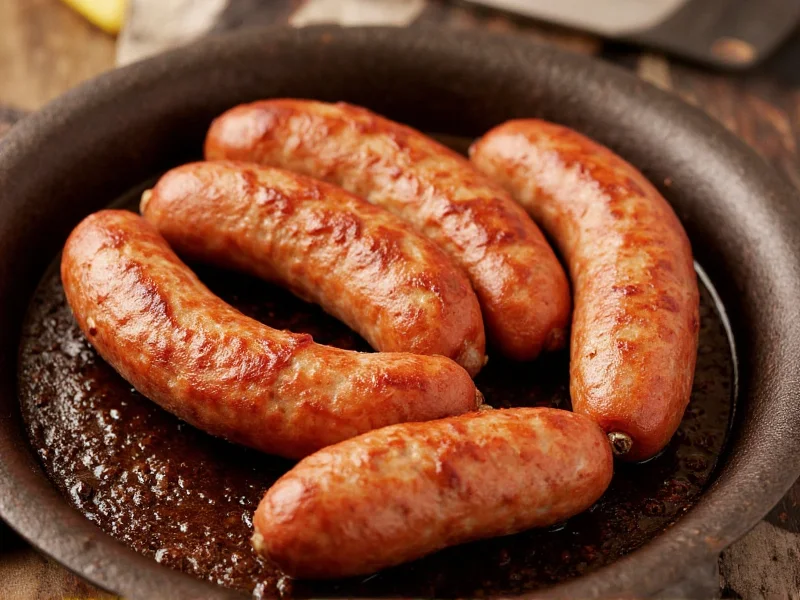Understanding the proper cooked sausage temperature is critical for both food safety and culinary success. Many home cooks rely on visual cues like color or texture to determine doneness, but these methods are unreliable and can lead to foodborne illness. The only accurate way to verify your sausages are safely cooked is by using a food thermometer to check the internal temperature.
Why Temperature Matters for Sausage Safety
Sausages present unique food safety challenges compared to whole cuts of meat. The grinding process distributes potential pathogens throughout the product, making thorough cooking essential. Undercooked sausage can harbor dangerous bacteria including Salmonella, E. coli, and Trichinella spiralis, which can cause serious foodborne illnesses.
The USDA Food Safety and Inspection Service establishes minimum internal temperatures to eliminate these risks. For cooked sausage temp verification, these standards aren't arbitrary—they're scientifically determined thresholds where harmful bacteria are destroyed within a specific timeframe.
Sausage Temperature Guidelines by Type
Different meats require different minimum temperatures due to varying fat content, density, and pathogen risks. Here's a detailed breakdown of recommended cooked sausage temperatures:
| Sausage Type | Safe Internal Temperature | Resting Time After Cooking |
|---|---|---|
| Pork, Beef, Lamb Sausages | 160°F (71°C) | 3 minutes |
| Chicken, Turkey Sausages | 165°F (74°C) | 3 minutes |
| Pre-cooked Smoked Sausages | 140°F (60°C) | None required |
| Game Meat Sausages | 160°F (71°C) | 3 minutes |
How to Properly Check Sausage Temperature
Using a food thermometer correctly is essential for accurate cooked sausage temp readings. Follow these steps for reliable results:
- Select the right thermometer: Use an instant-read digital thermometer for quickest, most accurate results
- Insert at the thickest point: Position the probe into the center of the sausage, avoiding contact with the cooking surface
- Check multiple sausages: Test several pieces since cooking may be uneven
- Wait for stabilization: Hold the thermometer in place until the reading stops changing (typically 10-15 seconds)
- Clean between readings: Sanitize the probe with hot, soapy water when checking different sausage types
Avoid common mistakes like testing only one sausage, inserting the thermometer at an angle that exits the other side, or relying on the color of the meat. Remember that sausage can remain pink even when properly cooked to 160°F due to curing agents or myoglobin retention.
Visual Indicators vs. Temperature Readings
Many cooks mistakenly believe that sausage should be brown throughout or that clear juices indicate doneness. These visual cues are unreliable for determining proper cooked sausage temperature:
- Pink color: Cured sausages often remain pink even at safe temperatures
- Clear juices: Some properly cooked sausages may still release pinkish juices
- Firm texture: Sausages can feel firm before reaching safe internal temperatures
- Float test: Some claim sausages float when done, but this indicates fat rendering, not safety
The only reliable method for verifying your sausage has reached the proper cooked sausage temp is using a calibrated food thermometer. This simple tool prevents both undercooking (safety risk) and overcooking (poor texture and flavor).
Special Considerations for Different Cooking Methods
The recommended cooked sausage temperature remains consistent regardless of cooking method, but technique affects how you achieve and verify that temperature:
Grilling: Create two-zone heat to move sausages away from direct flame if exterior browns too quickly before reaching safe internal temperature. Check temperature away from grill grates.
Pan-frying: Use medium heat to allow time for heat to penetrate to the center without burning the exterior. Rotate sausages periodically for even cooking.
Baking: Oven temperatures vary significantly, so rely on the sausage's internal temperature rather than baking time. Convection ovens may cook faster, requiring earlier temperature checks.
Smoking: Low-and-slow methods require patience—the sausage must still reach 160°F/165°F regardless of smoking duration. The smoke ring (pink layer beneath the surface) indicates smoke penetration, not doneness.
Storage and Handling After Cooking
Proper temperature management continues after your sausages reach the recommended cooked sausage temp:
- Holding temperature: Keep cooked sausages at 140°F (60°C) or above if serving buffet-style
- Refrigeration: Cool and refrigerate within 2 hours (1 hour if ambient temperature exceeds 90°F/32°C)
- Leftovers: Store in airtight containers for up to 3-4 days at 40°F (4°C) or below
- Reheating: Bring leftovers to 165°F (74°C) before serving
When transporting cooked sausages, use insulated containers to maintain safe temperatures. Never leave cooked sausage at room temperature for extended periods, as this creates ideal conditions for bacterial growth even if the food initially reached proper cooked sausage temperature.
Special Cases and Exceptions
While the standard cooked sausage temp guidelines apply to most commercially produced sausages, some specialty products have different requirements:
Pre-cooked smoked sausages: These only need to be heated to 140°F (60°C) for serving, as they're fully cooked during manufacturing. Always check packaging instructions.
Homemade sausages: If you make your own sausage, follow the same temperature guidelines but be extra vigilant about thermometer placement since fillings may be uneven.
Cured dry sausages: Products like salami don't require cooking but should be stored properly. These are exceptions to cooked sausage temperature rules.
Vacuum-sealed sous vide sausages: These may be cooked at lower temperatures for extended periods following specific food safety protocols, but this method requires precise temperature control.











 浙公网安备
33010002000092号
浙公网安备
33010002000092号 浙B2-20120091-4
浙B2-20120091-4